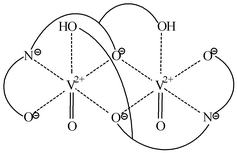Oxovanadium(IV) complexes of N-D-gluconylamino acids
Abstract
The complex formation between five N-D-gluconylamino acids (the derivatives of

* Corresponding authors
a
Biocoordination Chemistry Research Group of the Hungarian Academy of Sciences, University of Szeged, P.O. Box 440, Szeged, Hungary
E-mail:
gyurcsik@chem.u-szeged.hu; tkiss@chem.u-szeged.hu
b Department of Inorganic and Analytical Chemistry, University of Szeged, P.O. Box 440, Szeged, Hungary
The complex formation between five N-D-gluconylamino acids (the derivatives of

 Please wait while we load your content...
Something went wrong. Try again?
Please wait while we load your content...
Something went wrong. Try again?
B. Gyurcsik, T. Jakusch and T. Kiss, J. Chem. Soc., Dalton Trans., 2001, 1053 DOI: 10.1039/B009852N
To request permission to reproduce material from this article, please go to the Copyright Clearance Center request page.
If you are an author contributing to an RSC publication, you do not need to request permission provided correct acknowledgement is given.
If you are the author of this article, you do not need to request permission to reproduce figures and diagrams provided correct acknowledgement is given. If you want to reproduce the whole article in a third-party publication (excluding your thesis/dissertation for which permission is not required) please go to the Copyright Clearance Center request page.
Read more about how to correctly acknowledge RSC content.
 Fetching data from CrossRef.
Fetching data from CrossRef.
This may take some time to load.
Loading related content
